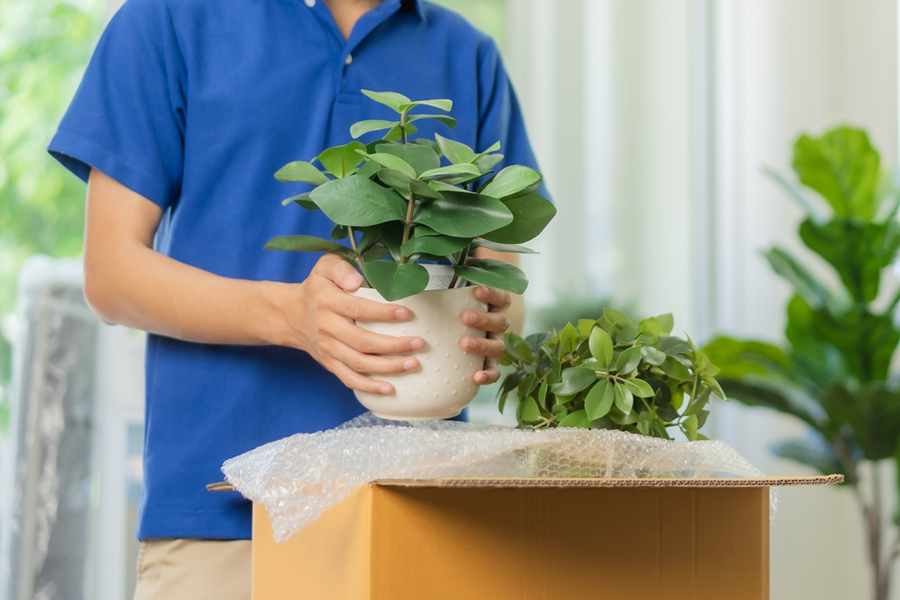
How To Move Plants Across State Lines?
When you’re moving long distance, planning ahead is essential — especially if you want to take your house plants. Keep in mind that all states have regulations for shipping plants and certification requirements, which means shipping plants cross-country requires more preparation than packing your clothes and kitchen utensils. Because of state laws, and because it’s not healthy to ship living items in a moving truck (lack of proper airflow, water, and sunlight), they’re on the Do-Not-Ship list for most companies — including Cord Moving and Storage agents for North American Van Lines. But even though moving plants takes a little extra time and thought, it’s possible. You’ll just need to follow the state laws you’re moving into and handle all greenery with care.
State laws for moving plants across the country
While most states allow indoor plants that are placed in sterilized potting soil to enter, states that rely heavily on healthy plants and crops like California, Florida, Hawaii, Arizona, and Idaho have stricter rules. For example, when shipping plants to California, you should know that California doesn’t permit citrus plants because they pose the possible threat of pest infestation (like the gypsy moth). And Hawaii doesn’t permit pineapple, passion fruit, or palm plants (check out the full list here) because of soil, insect, and disease risks.
So, before you begin packing the plants for moving, check the laws of the states you’ll be traveling through and the ones you’re moving to. Each state’s Department of Agriculture has guidelines to protect all vegetation within the border from harm. Following these rules is important to keep a balanced ecosystem — and it’ll keep you from paying a hefty fine or having your plants confiscated.
Should I take my plants with me?
It can be difficult to part with flowers, bushes, and shrubs you’ve grown and nurtured from seed. However, it’s important to think about what’s best for the plant. The following elements can help you decide whether or not to move the plants:
- Climate. Will your plants survive in the new climate you’re moving to? Plants that thrive in one part of the country could suffer or die in another. Take a look at the climate in your new location to determine how well your plants will prosper there.
- Light. Make sure there are enough sunny days for plants that need a lot of natural sunlight. On the other hand, not all foliage requires a lot of light — too much sun could actually bring harm. These plants will need an area in your new home that provides shade.
- Rainfall. Does your new state get too much rain or not enough? Dry plants need drier environments, while plants that require a lot of water need moister environments. Even plants that live in the house could be affected by the outside elements, especially if you plan to move them outside for a short period of time or during certain seasons.
If you decide it’s not a good idea to transport them, consider donating to the new owners of your home, friends, family, a local school, charity, nursing home, or nursery. Receiving a beautiful plant could really brighten up someone’s day!
How to ship plants across the country?
Even though most moving companies including Cord Moving and Storage agents for North American Van Lines aren’t able to move plants, there are some alternative ways to ship your plants quickly and safely.
- Take them in your vehicle.
This is the ideal solution because you have total control over the environment (temperature, light, ventilation and when or if they’re watered during transit). However, avoid putting them in the trunk where they’ll be cut off from all of those crucial elements. And if you’re stopping at hotels along the way, don’t forget to bring your potted plants and cuttings inside. This keeps them safe from extreme temperatures that are amplified inside a vehicle.
- Use a shipping service.
If you’re concerned about moving them in your car, or you’d just prefer not to, we recommend checking with tour local florist who can get a free quote online, and they offer a place to give specific handling and care instructions for your sensitive cargo. It’s a good alternative that can help ease your worries about how to transport them.
While it requires careful packaging and enough water to survive several days, shipping plants through the U.S. Postal Service is an option for plants, too. Just be sure to label the box “live plant” and send them as priority mail (1-3 business days) so that you can replant and care for them as soon as possible.
- Transport them by plane.
Shipping plants via an air freight service is an option also. For plants that need immediate attention, most can do the same day, which means your plants can arrive as early as the next morning.
If you’re flying to your new home you can also have them travel with you on your commercial flight. Just be sure to check with the Transportation Security Administration (TSA) to determine if it’s allowed in the locations you’re traveling from and to, and whether or not they can be transported as carry-on or checked baggage. Even if you’re plants are permitted, they’ll still be subject to screening. The final decision of whether or not they’ll board the plane with you is up to the TSA.
Whichever option you choose, make sure the plants are packaged and labeled properly and have all the required certificates. Keep in mind that they won’t receive special handling during the flight, so they may not hold up quite as well.
How to pack plants for moving?
If you’ve determined your new location is suitable for your plants, and you feel strongly about moving them, here are some of the best tips to move plants easily:
- Gather supplies.
- A sturdy moving box for each plant (make sure it’s a snug fit so the pot can’t move around)
- Plastic pots to replace clay pots during transit
- Sterilized potting soil
- Bubble Wrap®, packing paper or newspaper (to fill in extra spaces and line the boxes)
- Paper towels, plastic bags, and plant ties
- Flea collars (to rid the plant of pests)
- Prepare the plant
A few weeks before the move, you’ll want to re-pot the plants in plastic containers with fresh, sterile soil. Because most plants don’t like a change in container size, choose plastic pots that have similar dimensions to the clay ones. Plants need time to adjust to the new container before traveling so it’s wise to start re-potting them early.
After your plants are potted for the trip, inspect them for bugs. Put the flea collar in the base of the pot so that it can draw the pests out. Because certified inspections are required, call your local agricultural department to schedule an inspection with an authorized examiner. Once they’ve cleared your plants for travel, they’ll issue you a State Phytosanitary Certificate (or the form required by your state). Having this certificate is beneficial if you get stopped at state borders while passing through. If the plant is being shipped separately from you, just place the certificate inside the box with it.
Water them two to three days before moving. The soil should be moist, but not too wet. Most plants can withstand seven to 10 days without water, as long as the roots stay damp.
- Pack the plant
This part of the process could take some extra time, but it’ll be worth it when your plant arrives healthy and intact.
For packing potted plants follow these steps:
- Put a plastic bag over the pot and tie it just in case it tips during transit
- Place the plant in the box
- Fill in the extra space using Bubble Wrap®, packing paper, or newspaper
- Poke holes in the box to allow for airflow
- The label “live plant” and “fragile”
If your plants are too big to move, consider taking cutting of one instead. This may be more convenient for moving rose bushes or another large shrubbery. And cuttings can survive several days if properly cared for. Follow these steps for packing a cutting:
- Make a clean cut on the area of the flower or bush you want to take (It’s best to do this in the morning when the plant is fresh)
- Keep the ends moist by wrapping them in wet paper towels and securing them with plant ties, twist ties, or rubber bands
- Wrap the stem in a florist’s plastic stem holder (you know, those plastic sleeves that bouquets come in that can be found at a local florist shop)
Whether you’re packing a potted plant or a cutting, be sure it’s the last thing you pack, but the first item you unpack and care for at your new home.
Do you have more questions about moving live plants?
We’re happy to answer any additional questions you have about how to move with plants. While Cord Moving and Storage isn’t able to move plants, we specialize in moving household belongings long distance! Get a free moving quote or call a relocation specialist at 888-295-3374 to see how we can make your move easy and affordable. Happy moving and happy gardening!


